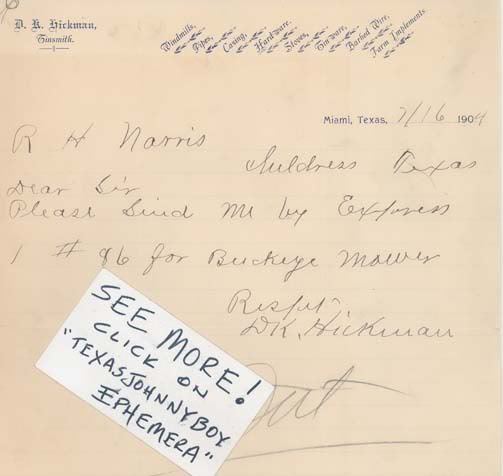-40%
1904 HICKMAN TINSMITH MIAMI TEXAS WINDMILL BARBED WIRE
$ 14.41
- Description
- Size Guide
Description
PLEASE READ BEFORE BUYING OR BIDDING!!I sell ONLY ORIGINAL items and NOT ANY reproductions.
This is for
ONE
LETTERHEAD
it is from
D. K. HICKMAN,
TINSMITH
located in
MIAMI, TEXAS
during the year of
1904
HICKMAN DID WINDMILLS, PIPES, CASINGS, HARDWARE, STOVES, TINWARE, BARBED WIRE, AND FARM IMPLEMENTS.
The letter is
HAND WRITTEN
AND
SIGNED
by
D. K. HICKMAN.
Condition:
It is not entirely shown in the scan, it is much larger and has normal letter folds and is in good condition.
Historical Notes ON
MIAMI, TEXAS
.
Miami, the county seat of Roberts County, is on U.S. Highway 60 between Canadian and Pampa in the
southeastern part of the county. It is in the Red Deer Creek valley, backdropped by a mesa called Mount Moriah. Miami supposedly derives its name from an Indian word meaning "sweetheart." The first settler on this site was Marion Armstrong, who in 1879 erected a half-dugout stagecoach stand near Red Deer Creek on the mail route from Mobeetie and Fort Elliott to Las Vegas, New Mexico. The town was platted in 1887 by B. H. Eldridge on the proposed route of the Southern Kansas (later Panhandle and Santa Fe) Railway. Samuel Edge and Mark Huselby purchased several lots and formed the Miami Townsite Company. Supplies for the railroad-construction crews were furnished by daily stages from Mobeetie. By 1888 Miami had 250 inhabitants and three hotels, three grocery stores, two saloons and a cafe, two livery stables, a post office, a mercantile store, a drugstore, and a tin shop. When Roberts County was organized in January 1889, Miami was chosen as county seat. The election, however, was declared fraudulent in December, and Parnell, twenty-five miles northwest, was the legal seat of county government until Miami won another election in November 1898. The present courthouse was built in 1913 to replace an earlier wooden structure.
Known as "the last real cowtown in the Panhandle," Miami became a shipping point for area ranches, including the Laurel Leaf, Turkey Track,
qqv
and Bar CC outfits. The town's
newspaper, the Miami
Weekly Echo
, began in 1894; the name was changed to Miami
Chief
in 1911. A bank was established in 1907, and the local schools opened in September 1910. Five churches were organized in Miami between 1898 and 1923. By 1915 the town had a population of 700. The first county fair was held there in 1923. Early prospects for oil in the vicinity resulted in the building of the Hillcrest addition in the late 1920s. Grain and cotton production also aided growth. A county library, housed in the courthouse basement, was established in the 1930s. In 1968 a tornado destroyed Miami High School, which was subsequently rebuilt. The town in the 1980s was a retail and shipping point for cattle and grain. In addition, it had some oil-related businesses. Its population was estimated at 656 in 1960, 611 in 1970, and 813 in 1980, when Miami supported twenty-six businesses. The Roberts County Museum, housed in the restored Santa Fe depot, contains, among other things, paleontological artifacts collected by Judge J. A. Mead in the 1930s. Miami holds a National Cow Calling Contest every June in the city park; the contest was begun in 1949 as part of the town's annual Old Settlers' Reunion. Miami, living up to its name, has continued to advertise itself as the "Sweetheart of the Plains." In 1990 it was an incorporated town reporting a population of 675 and thirty-seven businesses. The population dropped to 588 in 2000.
If you have any questions, please contact me!
Terms & Conditions
Payment to EBAY upon purchase
When you receive your item, PLEASE consider feed back (I will see it) and I will reciprocate feed back at that time.
Free shipping to Continental U.S. only
PLEASE view my other auctions and ebay store items for related ephemera, antique documents, and paper collectibles at
TEXASJOHNNYBOY EPHEMERA.
THANK YOU VERY MUCH AND
GOOD LUCK
Y'ALL !!









